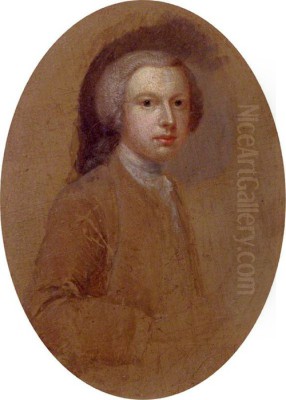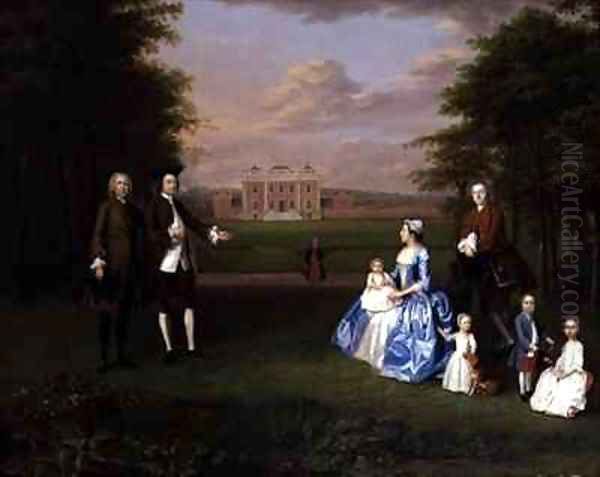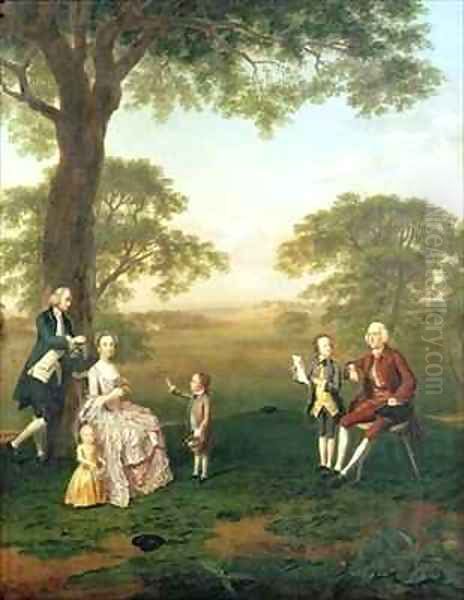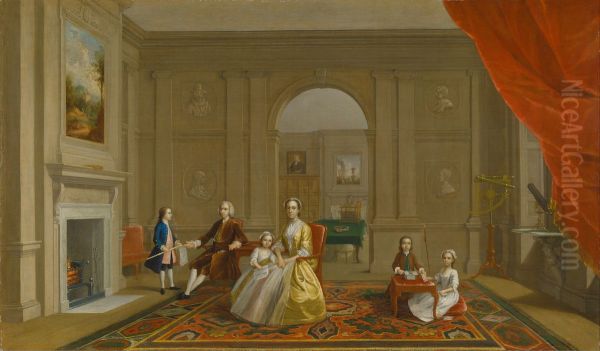
Arthur Devis stands as a significant figure in the landscape of eighteenth-century British art. Born in Preston, Lancashire, and baptised on February 19, 1712, he carved a distinct niche for himself primarily through his mastery of the "conversation piece" and his sensitive landscape paintings. Active during a period of burgeoning national confidence and wealth, particularly among the landed gentry and merchant classes, Devis's work offers a unique window into the aspirations, manners, and domestic lives of his patrons. While perhaps lacking the bravura or psychological depth of contemporaries like Sir Joshua Reynolds or Thomas Gainsborough, Devis developed a precise, detailed, and often charming style that perfectly suited the tastes of his clientele, leaving behind a valuable record of provincial English society. He passed away in Brighton on July 24, 1787.
Early Life and Artistic Formation
Arthur Devis hailed from a family with artistic inclinations. His father, also named Anthony Devis, was a carpenter and bookseller who held civic positions in Preston, including being a member of the town council. It is suggested that the elder Anthony may have had some artistic practice himself. Arthur was the eldest of four sons. Crucially, his younger half-brother, also named Anthony Devis (1729-1816), would go on to become a notable landscape painter in his own right, suggesting a shared familial environment where art was appreciated and possibly practiced.
The most significant step in Arthur Devis's formal artistic education was his apprenticeship to the Flemish painter Peter Tillemans (c. 1684-1740). Tillemans had settled in England around 1708 and established a successful practice, specializing in topographical views of country houses, sporting scenes (particularly equestrian subjects), and battle pieces. He worked in a detailed, somewhat linear style derived from Dutch and Flemish traditions. This training under Tillemans, likely occurring in the early 1730s, profoundly shaped Devis's own artistic approach.

From Tillemans, Devis absorbed a meticulous attention to detail, a clarity of composition, and techniques for rendering landscapes and architectural elements with precision. Tillemans's practice of painting country estates and depicting the leisure activities of the gentry also provided a direct model for the type of patronage Devis would later cultivate. Although Devis would primarily become known for his figure painting within conversation pieces, the foundational skills in landscape and setting acquired under Tillemans remained integral to his work throughout his career. Some sources suggest an earlier, less documented influence from a Liverpool portraitist named Hammel Winstanley, who himself had connections to Tillemans.
The Conversation Piece Perfected
While Devis produced pure landscapes, particularly early in his career, his most enduring contribution to British art lies in his development and popularization of the conversation piece. This genre, which had roots in Dutch 17th-century painting (artists like Gerard ter Borch and Gabriel Metsu depicted similar intimate domestic scenes) and was pioneered in Britain by artists such as William Hogarth and Gawen Hamilton, depicted small groups of figures, often families or friends, engaged in polite social interaction or quiet leisure within a domestic interior or a garden setting.
Devis, however, refined the conversation piece into a distinct formula that proved immensely popular with the provincial gentry and burgeoning merchant class, particularly in Northern England. His works in this genre are typically small in scale, differentiating them from the grander, life-sized portraits favoured by the aristocracy and executed by artists like Reynolds. Devis's figures are often presented with a certain stiffness, arranged somewhat formally within the composition, almost like carefully positioned dolls on a stage set. This doll-like quality, combined with the meticulous rendering of costume, furniture, and architectural details, lends his work a unique, slightly naive charm.
These paintings were more than mere portraits; they were statements about social standing, property, familial harmony, and adherence to the codes of polite society. The settings, whether elegantly appointed rooms or manicured gardens overlooking identifiable estates, emphasized the sitters' wealth and connection to their land. The inclusion of specific objects – books, musical instruments, tea sets, pets, sporting equipment – further alluded to their accomplishments, interests, and leisured lifestyle. The polite, often restrained interactions and gestures depicted reflected the contemporary emphasis on decorum and refined manners, as outlined in popular etiquette manuals of the period.
Notable Conversation Pieces
Devis's output was prolific, and numerous examples of his conversation pieces survive, offering fascinating glimpses into the lives of his patrons.
_Roger Hesketh with his Family_ (c. 1738-1740): An early example demonstrating Devis's emerging style. The figures are arranged in an interior that, while elegant, retains a connection to the Dutch tradition. The formal poses and the careful delineation of the space and furnishings are characteristic.

_Mr and Mrs Atherton_ (c. 1743): This double portrait, set against a backdrop suggesting their estate, showcases Devis's ability to integrate figures within a landscape setting, emphasizing land ownership as a key component of gentry status. The somewhat rigid poses are typical, but the attention to costume detail is already evident.
_Robert Gwillym of Atherton and His Family_ (1745-1747, Yale Center for British Art): Often considered one of Devis's masterpieces in the genre. It depicts the family in an idealized landscape setting, likely representing their Herefordshire estate. The composition is carefully balanced, presenting an image of harmonious family life, prosperity, and connection to nature – a utopian vision of landed gentry existence. The detail in the foliage and the distant view showcases his landscape skills.
_Mr. and Mrs. Richard Bull of Northcourt_ (1747, National Gallery of Art, Washington D.C.): This work exemplifies the quiet elegance Devis achieved. The couple is portrayed in a refined interior, their poses conveying a sense of propriety and mutual regard. The meticulous rendering of fabrics, furniture, and the view through the window are hallmarks of his style.
_The James Family_ (c. 1751): A classic Devis conversation piece showing multiple family members interacting politely in a well-appointed room. The arrangement of figures, the detailed rendering of the interior, and the slightly stiff, doll-like quality of the sitters are characteristic.
_The Vanneck Family_ (c. 1752): Depicting Sir Joshua Vanneck and his family, this work shows Devis catering to a wealthy merchant family, indicating the broadening appeal of the conversation piece beyond the traditional landed gentry. The setting is opulent, reflecting the family's status.
_The Clavey Family_ (c. 1754): This painting is notable for its slightly more relaxed grouping compared to some of Devis's earlier works, though the characteristic precision and detailed setting remain. It captures the family in a moment of quiet domesticity, reinforcing the ideals of familial harmony and genteel leisure.
These works, among many others, cemented Devis's reputation as the go-to painter for families seeking a refined, detailed, and socially appropriate record of their lives and status, presented on an intimate scale.
Landscape Painting and Style
Although overshadowed by his conversation pieces, Arthur Devis was also an accomplished landscape painter, a skill honed during his apprenticeship with Peter Tillemans. His early independent works included topographical views and hunting scenes, directly reflecting his master's influence.

_Hoghton Towers from Duxon Hill, Lancashire_ (1735, Private Collection): This early landscape is significant, demonstrating the meticulous detail, careful composition, and use of thin, transparent glazes that Devis learned from Tillemans. It provides an accurate rendering of the prominent local landmark, fulfilling the demand for topographical views of country estates.
Even within his conversation pieces, the landscape often played a crucial role, serving not just as a backdrop but as an indicator of the sitters' property and connection to the land. Devis's landscape style combined topographical accuracy with a gentle, somewhat romanticized vision of the English countryside. His vistas are typically serene, bathed in a cool, clear light, and often include small figures, animals, or boats that add touches of life and narrative interest without dominating the scene.
Compared to the idealized, classical landscapes of artists like Claude Lorrain, whose influence was strong in Britain, or the more dramatic, naturalistic landscapes that would later be developed by painters like Thomas Gainsborough or John Constable, Devis's approach was quieter and more descriptive. His work in landscape shares some affinities with that of his half-brother, Anthony Devis, who specialized solely in landscape and developed a more picturesque style. Arthur's landscapes, like his conversation pieces, possess a distinct, slightly miniaturized quality, emphasizing clarity and detail over atmospheric grandeur.
Artistic Technique and Characteristics
Arthur Devis's style is highly recognizable, marked by several consistent characteristics:
Meticulous Detail: Devis paid extraordinary attention to the rendering of surfaces, textures, and details, particularly in clothing, furniture, and architectural elements. Lace, silk, polished wood, and foliage are often depicted with painstaking care.
Smooth Finish: His paint application is typically smooth and controlled, with little visible brushwork, contributing to the polished, refined appearance of his works.
Cool Palette: Devis often favoured a palette dominated by cool blues, greens, greys, and silvery tones, contributing to the calm, sometimes detached atmosphere of his paintings.
Doll-like Figures: His figures, while accurately capturing likenesses in terms of features and costume, often appear somewhat stiff, posed, and lacking in deep psychological expression. They have been described as resembling finely crafted dolls arranged in a scene.
Specific Lighting: Light in Devis's paintings is usually clear, even, and cool, illuminating details precisely but rarely used for dramatic chiaroscuro effects in the manner of artists like Rembrandt or Joseph Wright of Derby.
Emphasis on Setting: The environment – whether an interior or a landscape – is given significant prominence, often occupying as much, if not more, visual importance as the figures themselves. The setting is integral to conveying the sitters' status and lifestyle.
Naive Perspective/Anatomy: While generally competent, Devis's handling of perspective and anatomy can occasionally appear slightly awkward or naive, particularly in the relationship between figures and their surrounding space. This contributes to the distinctive charm and slightly stylized quality of his work.
This combination of meticulous realism in detail with a certain formality and stiffness in the figures creates the unique "Devis style" – precise, elegant, socially informative, yet possessing a distinct, almost miniaturist charm.
Career, Patronage, and Professional Life
After completing his training, Devis established his practice. He married Elizabeth Fawkner (1721-1788) on July 20, 1742, at St Alban's, Wood Street, London. Elizabeth came from a Lancashire family, and these regional connections proved beneficial, helping Devis secure commissions from the gentry and merchant families of Northern England, who formed the core of his clientele. The couple settled in London, living in Great Queen Street, Lincoln's Inn Fields, from the mid-1740s, an area popular with artists. They had a large family, with some twenty-two children recorded, though many likely died in infancy. Two sons, Thomas Anthony Devis (1757-1810) and Arthur William Devis (1762-1822), followed their father into the profession, becoming painters themselves. Arthur William, in particular, achieved considerable success, working notably in India.
Devis exhibited his work publicly, though not extensively compared to some contemporaries. He showed paintings at the Free Society of Artists between 1761 and 1775, and again in 1780. He served as President of the Society in 1768, indicating a respected position among his peers. He exhibited less frequently at the rival Society of Artists (1762, 1763) and only showed one work at the prestigious Royal Academy of Arts, in 1780. His primary source of income remained private commissions rather than public exhibition sales.
His patrons were largely drawn from the ranks of the landed gentry, successful merchants, and professionals, particularly those with connections to Lancashire and the North West. Families like the Heskeths, Athertons, Bulls, Lister, and Claveys sought him out to record their families, homes, and social standing in his distinctive, refined style.
Devis also took on pupils. His most notable apprentice was perhaps Robert Marris, who became a competent painter. Another apprentice, George Senhouse, taken on in 1752, was reportedly dismissed after three years for laziness, though he later found success as a landscape painter. His own sons, Thomas Anthony and Arthur William, also received training from him.
Later Years and Shift in Taste
By the 1760s and 1770s, artistic tastes in Britain began to shift. The grand manner portraiture promoted by Sir Joshua Reynolds, the first President of the Royal Academy, and the fluid, more psychologically penetrating portraits of Thomas Gainsborough came into vogue, particularly among the higher echelons of society. The detailed, somewhat stiff, and small-scale format of Devis's conversation pieces began to seem old-fashioned to some patrons. While he continued to receive commissions, the peak of his popularity had passed.
Reflecting this shift, or perhaps seeking alternative income streams, Devis increasingly turned to picture restoration in his later career. This was skilled work, requiring knowledge of painting techniques and materials. His most significant restoration project was undertaken between 1777 and 1778, when he was paid the substantial sum of £1000 to clean and restore Sir James Thornhill's vast painted ceiling and wall decorations in the Painted Hall at the Royal Hospital for Seamen, Greenwich. He also undertook restoration work for patrons like Sir Roger Newdigate at Arbury Hall.
In 1783, Devis sold his collection of pictures and retired from London, moving to Brighton, then a developing seaside resort. He died there four years later, on July 24, 1787, and was buried in the churchyard of St Mary Paddington, London.
Contemporaries and Artistic Context
Arthur Devis operated within a vibrant and evolving British art world. His master, Peter Tillemans, connected him to the Flemish and Dutch traditions popular in early 18th-century Britain. His work in the conversation piece genre places him alongside pioneers like William Hogarth, though Hogarth's works were often satirical and narrative-driven in a way Devis's were not. Other practitioners of the conversation piece included Joseph Highmore and Francis Hayman, each with their own stylistic variations.
Later in Devis's career, Johann Zoffany emerged as a highly fashionable painter of conversation pieces, often depicting theatrical scenes or royal patronage with a greater sense of liveliness and informality than typically found in Devis's work. The dominant figures of the era, Reynolds and Gainsborough, represented a different scale and ambition in portraiture, focusing on individual likeness, character, and bravura technique, moving away from the detailed group format that Devis excelled at.
While the source material mentions a possible influence from the Italian Baroque painter Giovanni Battista Tiepolo, this connection seems less direct in Devis's typical output than the clear lineage from Dutch genre painting and the style of his master, Tillemans. His meticulous technique and focus on domesticity align more closely with Northern European traditions than with the flamboyant energy of Italian Baroque or Rococo art. His work provides a fascinating contrast to the grander history paintings and portraits that dominated academic discourse, offering instead an intimate portrayal of a specific segment of British society.
Legacy and Influence
For much of the 19th and early 20th centuries, Arthur Devis was a relatively overlooked figure, overshadowed by the giants of the Royal Academy like Reynolds and Gainsborough. His precise, somewhat formal style fell out of fashion, and the intimate scale of his work did not fit the prevailing taste for grander statements.
However, from the mid-20th century onwards, there has been a significant reassessment and appreciation of his work. Art historians and curators recognized the unique value of his paintings as social documents, offering unparalleled insights into the material culture, manners, and self-perception of the English provincial gentry during the Georgian era. His meticulous rendering of costume, interiors, and landscapes provides invaluable information for social historians.
Furthermore, the distinctive aesthetic qualities of his work – the clarity, the detail, the naive charm, the cool elegance – came to be appreciated in their own right. He is now firmly established as a leading master of the conversation piece, a genre that captures a particular aspect of British cultural life. While his direct influence on subsequent generations of painters may have been limited compared to his more famous contemporaries, his work represents a significant and distinct strand within British art history.
His paintings capture a sense of quiet order, domestic harmony, and pride in property that resonated deeply with his patrons. They are images of aspiration and stability, presented with a clarity and precision that gives them enduring appeal. Arthur Devis may not have aimed for the dramatic or the profound, but in chronicling the world of the English gentry with such care and distinctive style, he created a unique and valuable artistic legacy.
Collections
Works by Arthur Devis are held in numerous public collections, primarily in the United Kingdom and the United States. Key institutions include:
Yale Center for British Art, New Haven: Holds several important works, including Robert Gwillym of Atherton and His Family.
National Gallery of Art, Washington D.C.: Houses paintings such as Mr. and Mrs. Richard Bull of Northcourt.
Tate Britain, London: Includes examples of his portraiture.
National Portrait Gallery, London: Holds portraits attributed to Devis.
Harris Museum & Art Gallery, Preston: Located in his hometown, this museum has a significant collection of works by both Arthur Devis and his half-brother Anthony Devis.
Victoria and Albert Museum, London: Possesses works representative of his style.
Various regional museums across the UK, particularly those in Northern England, also hold examples of his work, reflecting his strong connections to the region.
Numerous paintings remain in private collections, occasionally appearing on the art market.